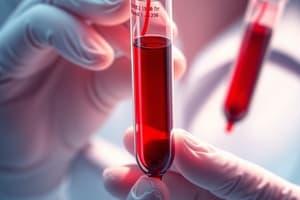Podcast
Questions and Answers
What is the specimen type for the red tube?
What is the specimen type for the red tube?
- Serum
- Plasma
- Whole blood
- Clotted whole blood or serum (correct)
What is the primary use of the gold or red/gray tube?
What is the primary use of the gold or red/gray tube?
Most chemistry tests
What additive is found in the lavender tube?
What additive is found in the lavender tube?
- Heparin
- Thrombin
- SPS
- EDTA (correct)
What blood specimen is associated with the green tube?
What blood specimen is associated with the green tube?
The yellow sterile tube is used for ______ culture.
The yellow sterile tube is used for ______ culture.
What does the gray tube test for?
What does the gray tube test for?
What is the important note about filling the light blue tube?
What is the important note about filling the light blue tube?
The royal blue tube is used for clinical toxicology and trace metals.
The royal blue tube is used for clinical toxicology and trace metals.
Match the following tube colors with their uses:
Match the following tube colors with their uses:
What is the additive in the orange and yellow gray tube?
What is the additive in the orange and yellow gray tube?
Flashcards are hidden until you start studying
Study Notes
Phlebotomy Tube Colors and Uses
-
Red Tubes
- Used for chemistry, serology, and blood bank tests
- No additives; specimen is clotted whole blood or serum
- Requires 30 minutes for clotting
-
Gold or Red/Gray Tubes
- Ideal for most chemistry tests
- Contains clot activators and thixotropic gel; specimen is serum
- Commonly referred to as serum separator or Tiger tops
-
Green Tubes
- Tests include stat chemistry, ammonia, electrolytes, and arterial blood gases (ABG)
- Contains heparin with sodium lithium or ammonium ion; specimen is plasma
-
Light Green Tubes
- Specifically for stat potassium tests
- Contains heparin and thixotropic gel; specimen is plasma
- Also known as plasma separator tubes
-
Orange and Yellow Gray Tubes
- Used for stat chemistry tests
- Contains thrombin; specimen is serum
- Clotting time is 5 minutes; suitable for anticoagulant therapy
-
Lavender Tubes
- Primarily for hematology tests
- Contains EDTA; specimen is whole blood
- If powdered EDTA is used, tap the tube before drawing blood and fill 2/3 full
-
Black Tubes
- Used for sedimentation rate tests
- Contains sodium citrate; specimen is whole blood
- Must be filled completely to maintain a 4:1 ratio of blood to citrate
-
Light Blue Tubes
- Designed for coagulation tests
- Contains sodium citrate; specimen is plasma
- Fill completely to maintain a 9:1 ratio of blood to sodium citrate
-
Gray Tubes
- Used for fasting blood sugar, glucose, alcohol levels, and lactic acid tests
- Contains antiglycolytic agent and heparin; specimen is plasma
-
Royal Blue Tubes
- Meant for toxicology, trace metals, and nutrients testing
- Can contain heparin, EDTA, or no additives; specimen is plasma or serum
- These tubes are specially clean to prevent contamination
-
Tan Tubes
- Specific for lead analysis
- Contains heparin; specimen is plasma
- Formulated to contain less than 0.1 micrograms of lead
-
Yellow Sterile Tubes
- Used for blood culture tests
- Contains SPS; specimen is whole blood
- Designed to recover microorganisms causing blood infections
-
Yellow Non-Sterile Tubes
- Tests for human leukocyte antigen and paternity testing
- Contains acid citrate dextrose; specimen is whole blood
- Dextrose preserves erythrocytes and citrate acts as an anticoagulant
-
Pink Tubes
- Designed for antibody screening and compatibility tests
- Contains EDTA; specimen is serum
Studying That Suits You
Use AI to generate personalized quizzes and flashcards to suit your learning preferences.



